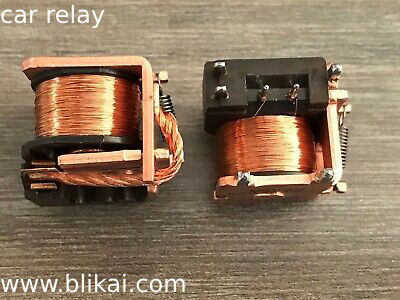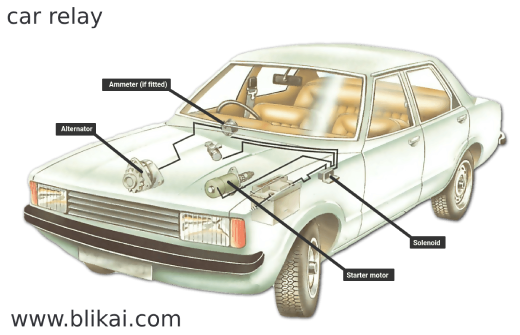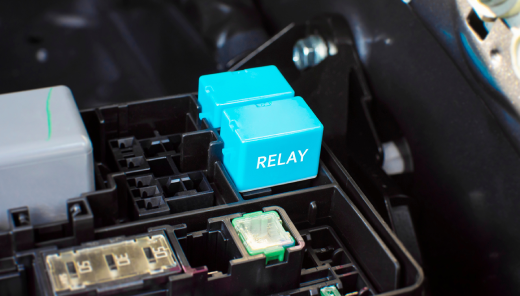I. Introduction
An electrically powered switch that manages a high current circuit with a weak current signal is called a car relay. It serves as a bridge between low-power electronic components and high-power components like motors, lights, and solenoids, making it an essential component of automobile electrical systems. Relays are essential to the effective and secure operation of a car’s many systems.

II. Components of a car relay
A. Switch
Typically, conductive materials like copper or silver are used to make cars control switches. It is made to sustain high currents without melting the contacts or overheating. The contacts of the switch move from one position to another, opening or closing the circuit, when the relay winding is powered. By doing this, the relay may regulate how much electrical current flows to a linked device—like a light fixture or motor.
B. Coil
A car relay’s winding is a crucial part of the device. Usually, an iron core is encircled by copper wire. The winding creates a magnetic field that pulls on the switch’s contacts, moving them when an electric current flows through it. The design of the winding and the quantity of windings dictate the relay’s operational parameters, including the voltage and current needed to activate it.
C. Electromagnetic Field
An electromagnetic field is produced when a current flows through a relay coil. The switch contacts move as a result of the force this field applies to them. The polarity of the magnetic field and, in turn, the direction in which the switch contacts move are determined by the direction in which the current flows through the coil. The relay can be used to turn on and off high power circuits with a low power signal by passing current through the winding.
III. How a car relay works
A. Normal closed (NC) position
The circuit between the common terminal and the normally closed terminal is closed when the relay switch contacts are in the typically closed position because the spring holds them together. This eliminates the requirement to activate the relay coil in order to allow current to pass through a connected device, such as a motor or light fixture. The switch contacts move to the typically open position when the relay winding is energized because the electromagnetic force is greater than the spring voltage, which breaks the circuit.
B. Normal open (NO) position
When the relay is in the typically open position, the circuit between the normally open terminal and the common terminal is broken because the switch contacts are kept apart from the spring. This stops the linked device’s current flow unless the relay coil is turned on. The switch contacts are pulled into the typically closed position by an electromagnetic force when the relay winding is energized, completing the circuit and permitting current to flow.
C. Functionality of the electromagnetic coil
The relay’s electromagnetic coil is its fundamental component. The coil creates a magnetic field that pushes on the switch’s contacts, moving them when an electric current flows through it. The polarity of the magnetic field and, in turn, the direction in which the switch contacts move are determined by the direction in which the current flows through the coil. The relay can be used to turn on and off high power circuits with a low power signal by passing current through the winding.

IV. Types of car relays
A. Single pole single throw (SPST) relay
The most basic kind of relay is the SPST, which has just one set of switch contacts that can be either open or closed. When the switch contacts are closed, current can pass through the relay and the system is in its usual state. The switch contacts open and the circuit is cut off when the relay winding is activated. Applications where only one circuit needs to be regulated often use SPST relays.
B. Single pole double throw (SPDT) relay
A single pair of switch contacts on an SPDT relay can be linked to either of the two terminals. The switch contacts are connected to a normally closed terminal while in one position and to a normally open terminal when in the other. When it’s necessary to switch the circuit between two states, SPDT relays are employed.
C. Double pole double throw (DPDT) relay
Each of the two sets of switch contacts on a DPDT relay can be linked to one of the two terminals. As a result, the relay may simultaneously manage two different circuits. When it’s necessary to manage several circuits, such as to switch between two power sources or reverse the direction of a motor, DPDT relays are frequently utilized.

V. Common uses of car relays
A. Starter motor
Car relays are frequently driven by starter motors. The relay is activated by applying a tiny current to the relay coil through the ignition key. More electricity can pass from the battery to the starter motor when the relay switch contacts close. To overcrank the motor and overcome its resistance, a greater current is required. Without the relay, the ignition switch would be forced to manage the high current that the starter motor demands, which might lead to an early failure.
B. Fuel pump
Fuel pump control is another typical car application for relays. Fuel is drawn from the fuel tank by the fuel pump and burned in the engine to power the car. The fuel pump needs a high current to function, just as the starter. The computer or ignition switch of the car can send a low-power signal to a relay, which can then regulate the current. This keeps the switch from getting damaged and guarantees the fuel pump will work reliably.
C. Headlights
Car relays also regulate the headlights. In order to generate the brilliant light necessary for safe nighttime driving, headlamps need a significant amount of electricity. Through the use of a low-power signal from the headlight switch, a relay can be used to manage current. This keeps the switch from failing too soon by preventing it from having to resist the high current needed for the headlamps. Furthermore, the headlamps may be turned on and off fast and effectively with a relay instead of overly taxing the switch.
VI. Conclusion
In conclusion, car relays are straightforward yet crucial parts of car electrical systems. Without them, controlling powerful devices like heaters, lights, and motors would be far more difficult and unreliable. Vehicle owners may assure the continuous safe and effective operation of their cars and save time and money on repairs by learning how relays operate and how to fix common relay problems. For the upkeep and maintenance of contemporary cars, having a solid understanding of the car relays is crucial, regardless of whether you work as a professional mechanic or at home.
